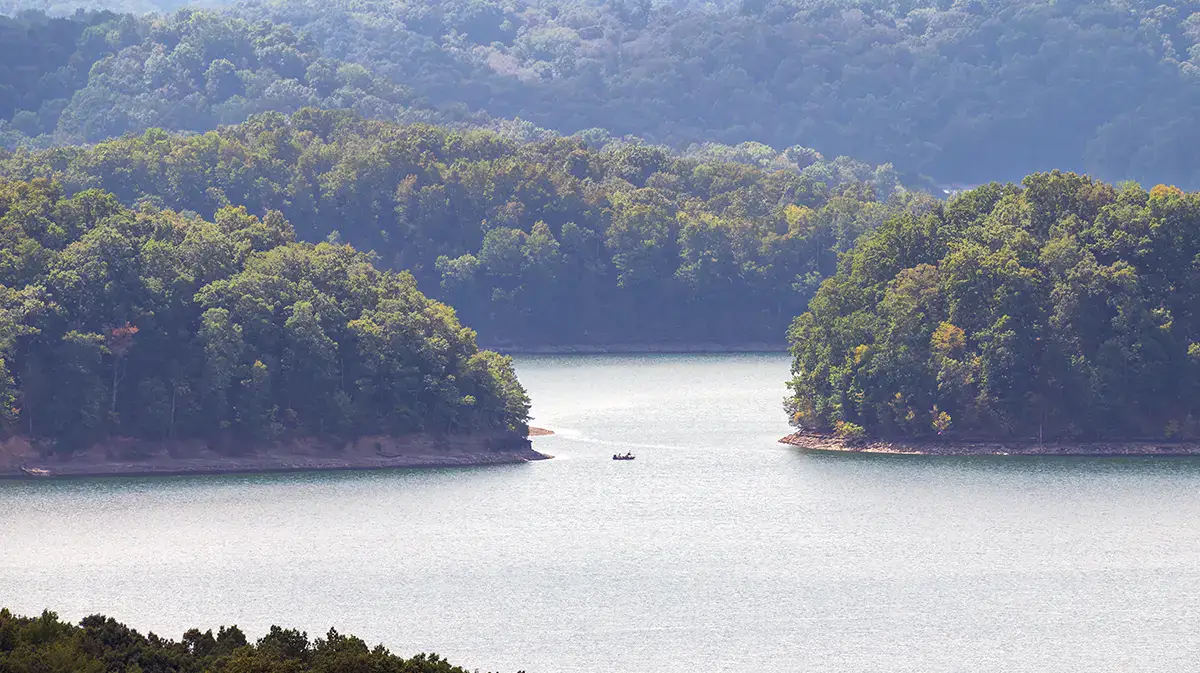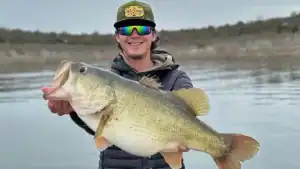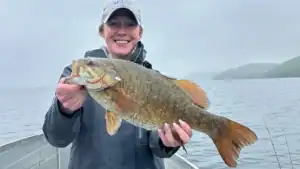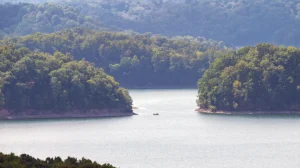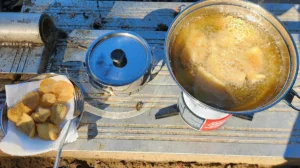David Hayes put Dale Hollow Reservoir, sometimes called Dale Hollow Lake, on the national map in the summer of 1955 when he and his family went fishing for a few hours. As Hayes, an experienced smallmouth angler, trolled a pearl-colored Bomber crankbait through two weed beds, he felt a giant tug at the end of his line. At first, he thought he was hung up. But the powerful pull of a big smallmouth bass told him otherwise.
Eventually, he got the giant to the boat and netted it. Then he took it to a marina and got it weighed on certified scales. To his surprise, he had a world-record fish — a smallmouth that registered 11 pounds, 15 ounces. That record was threatened when an affidavit accusing Hayes of tampering with the fish was discovered years later. But an investigation concluded that Hayes had done everything legally and he kept his record. And Dale Hollow, a 22,700-acre reservoir on the Tennessee-Kentucky line, became a national destination for smallmouth fishermen.
Much has changed over the years. Anglers still catch plenty of smallmouths, just not as many of them are giants. But those big ones are still in there, fisheries biologists say.
“At a lot of reservoirs, the smallmouth population will ebb and flow,” Marcy Anderson, a fisheries biologist for the Kentucky Department of Fish and Wildlife told Wired2fish. “But Dale Hollow is just consistent. It’s a classic smallmouth lake.
“In our surveys, we’ll still see fish 20 inches and over. And we still have good numbers, too. It’s not always easy to fish. Dale Hollow can humble you. But the fish are there.”
The Right Ingredients

Guides and other fisheries managers agree that Dale Hollow is a special place for smallmouth bass. With its deep, clear water, rocky habitat, islands, and the fish’s good genetic makeup, the bronze fish thrive here.
“It is not uncommon for us to interview anglers who have caught 20-40 smallmouth in one day during peak seasons, many of which are 3 to 5 pounds and some bigger,” said Mike Jolley, a regional fisheries manager for the Tennessee Wildlife Resources Agency (TWRA).
However, anglers who come to Dale Hollow in hopes of catching another world record likely will be disappointed. Jolley said that fish was estimated to be 12 years old when it was caught in 1955, which means “it literally started with the reservoir and enjoyed the high productivity that a new reservoir offers.”
In other words, it was one of a kind, as its long-standing status as a world record would indicate.
Still, there are plenty of chunky smallmouth bass roaming Dale Hollow’s clear water. In 2000, Tennessee and Kentucky established a slot limit on smallmouth bass, protecting fish measuring 16 to 21 inches. Regulations also reduced the daily limit to only one fish greater than 21 inches and one under 16 inches. Fisheries managers are convinced that regulation has helped Dale Hollow’s smallmouth population.
”This (slot limit) has protected the greatest quality smallmouth bass,” Jolley said. “It ensures great spawning potential as well as protecting against overharvest and potential loss through associated summertime tournament mortality.”
Just the same, trophy catches don’t come along every day.
How To Catch Them
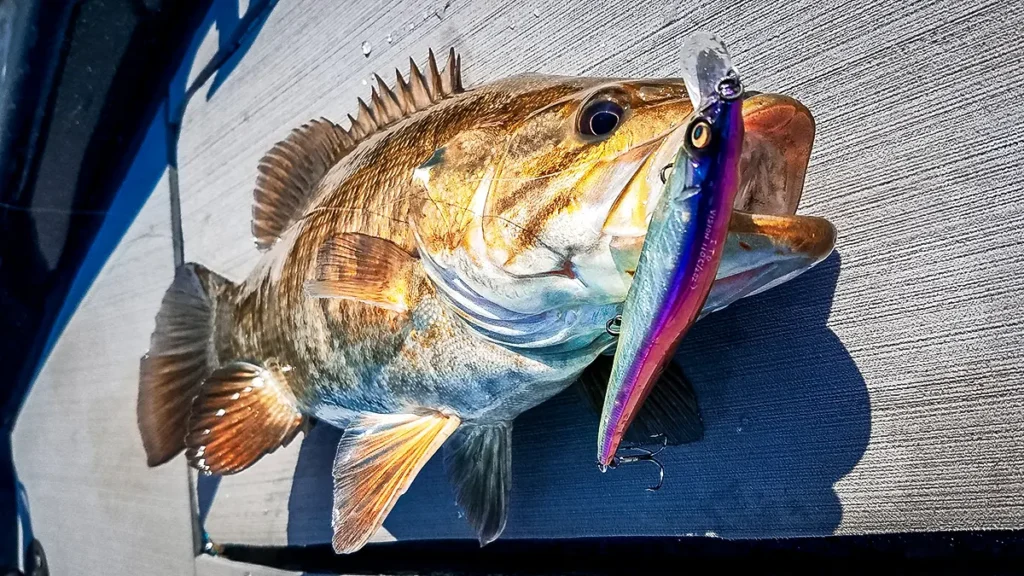
“Fish don’t behave the same way at Dale Hollow as they do at other lakes,” said Dave Clark, who runs the Dale Hollow Dave guide service. “We have a lot of suspended smallmouths in Dale Hollow. We’ll catch smallmouths in water as deep as 50 feet. That makes it harder to fish for the average fisherman.”
Smallmouth bass can be caught literally every month, Clark said. You just have to adjust your methods to where the fish are.
The smallmouth spend months roaming deep, open water, chasing shad and alewives. That’s when Clark likes to stay on the move, trolling with planer boards and even downriggers to get his baits to the desired depths. He likes to use big crankbaits such as the Bomber Fat Free Shad or jerkbaits to imitate the baitfish. He looks forward to the pre-spawn and post-spawn phases when the fish move from the depths to the shallower areas.
Isaac Peavyhouse, who runs the Dale Hollow Bass Guide Service, agrees that March and April and October and November are the best time slots to catch good-sized smallmouths bass.
He starts in March, when he finds success casting crankbaits such Spro RkCrawlers to transition areas before the fish move in to spawn in April. Gravel or rocky banks and points can be productive. He will also find success casting bass jigs with plastic trailers.
Post-spawn is a great time to catch the smallmouths on topwater baits. His favorite lure is a Yank-Um Custom Tackle Peanut.
“I can’t tell you how many smallmouths I’ve caught using the Peanut over deep, rocky points or main-lake weedbeds,” he said.
Once it gets hot, the smallmouths will usually be off-shore. That’s when Peavyhouse uses forward-facing sonar to target smallies chasing baitfish.
By the fall, the smallmouth often go on a feeding spree as they prepare for winter. Peavyhouse will use forward-facing sonar to look for the bass suspended over deep-water areas such as deep channels. He also casts a bass jig with a plastic trailer to bluff walls and rocky points.
“Sometimes, they’re only 5 to 20 feet down, suspended over deeper water,” he said. “I idle these creek channels until I see good schools of bait, then I fish there.
“We’ve had days when we’ll catch 30 to 40 smallmouths.”
The Night Bite

Greg Brisendine turns nocturnal once spring arrives. “I go nocturnal the first of April and I don’t go back to daytime fishing until mid-October,” he said.
Why? Brisendine believes the smallmouth are more relaxed and feed more actively at night on the reservoir that can get heavy fishing and boating pressure.
“Probably 75 percent of my fishing is at night,” said Brisendine, who runs Dawn to Dusk Guide Service. “Dale Hollow is a deep, clear lake, and the smallmouth will come up to feed once it’s dark. The bite is more consistent at night.”
Brisendine likes to throw a one-quarter-ounce bucktail hair jig that he ties. He pairs it with a Zoom Skinny Chunk as a trailer and casts it to rocky main lake and secondary points. “Late spring can be really good,” Brisendine said. “Around the first of June, you have to throw right up to the bank to get hit. If you’re not splashing water onto the bank when your jig lands, you’re not close enough.”
Brisendine uses a homemade 7-foot medium heavy baitcasting rod that he fashioned out of a St. Croix blank. His choice for line is 10-pound braid.
Dale Hollow Facts

- Location: On the Kentucky-Tennessee border. Most of the reservoir lies in the northern Tennessee counties of Clay, Pickett and Overton counties. But arms of the lake extend into the Kentucky counties of Cumberland and Clinton.
- Size: 27,700 acres; 620 miles of shoreline.
- Age: The U.S. Army Corps of Engineers finished construction in 1943.
- Origin: Dale Hollow Reservoir was formed by damming the Obey River near its juncture with the Cumberland River.
- Purpose: It was constructed mainly for flood control, although hydropower and recreation also are priorities.
- Characteristics: Dale Hollow is a deep, clear reservoir dotted with islands and bordered by steep, wooded hillsides. Because of its scenic beauty, it is a popular vacation destination.
- Claim to fame: The world-record smallmouth bass was caught at Dale Hollow in 1955; six of the nation’s top 10 all-time biggest smallies were caught at Dale Hollow.
- Lodging: Dale Hollow offers everything from traditional lodging — campgrounds, resorts and motels — to the not-so-traditional such as houseboats, which can be rented at most marinas. For information, go here.
- Boat ramps: Dale Hollow has many places to launch a boat, from U.S. Army Corps of Engineers sites to marinas to state parks.
Vacation Tips
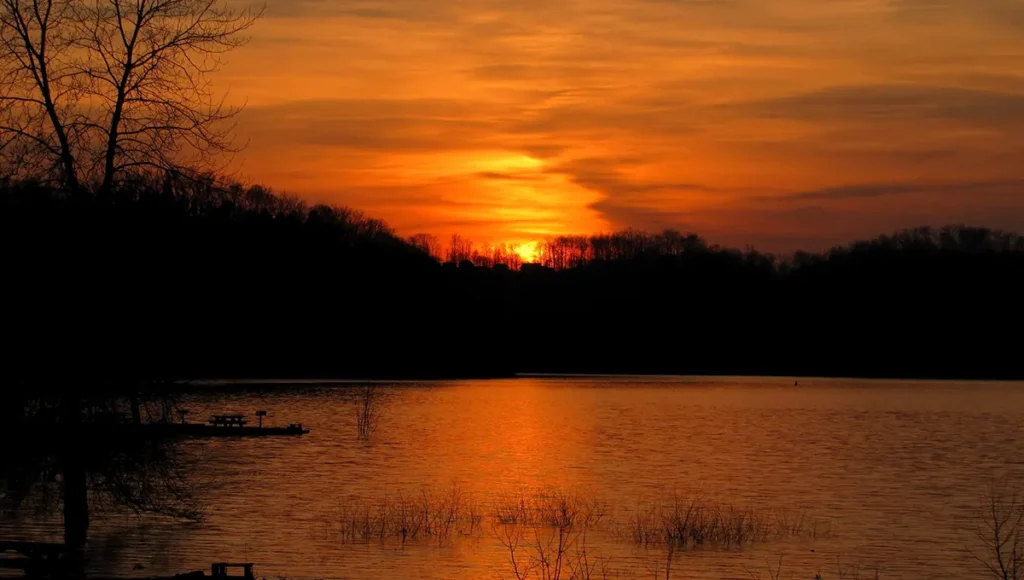
Looking for family activities at Dale Hollow? There’s plenty. It’s a popular vacation destination.
Visit Dale Hollow Lake State Resort Park on the Kentucky side of the reservoir. Stay in Mary Ray Oaken Lodge that sits atop a towering bluff. Hike to Eagle Point Overlook for a stunning view of the lake, pitch a tent in the campground or take a guided tour of some of the region’s caves. Book a stay at one of the many lakefront resorts and swim or rent a boat. Or just relax.
Dale Hollow is renowned as one of the most beautiful reservoirs in the nation. Combine that with a chance of catching your personal-best smallmouth bass, and it’s definitely a place to put on your bucket list.
